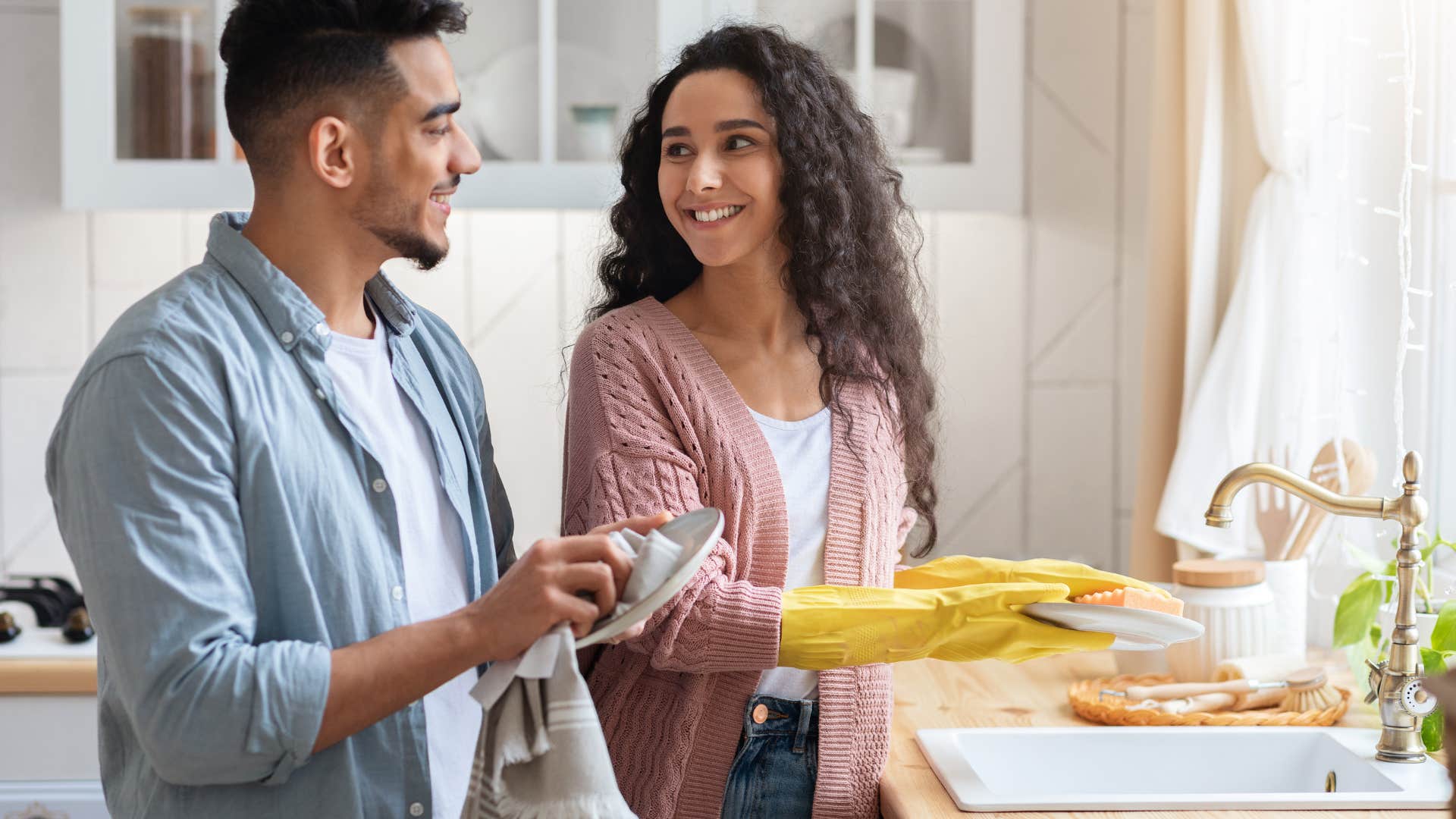If A Couple Truly Loves Each Other From The Depths Of Their Heart, They Will Do These 7 Things On A Regular Basis
Seven ways couples naturally protect and nurture their deepest bond: each other.
 Stel Antic | Canva
Stel Antic | Canva Given the way society has changed, you might be surprised to learn that women continue to shoulder the bulk of household labor within every age demographic and community in America. This is true among hourly earners and salaried professionals as well as C-Suite executives, judges, and athletes.
A quarter of the way through the 21st century, we still have the same conversations about the huge volume of work at home constantly referenced as “women’s work” that should be called “household management.” Enough already. Many couples thrive in relationships rooted in equality, understanding that there isn't a gendered nature to our household work. Here are a few ways couples who love each other deeply and equally do just that.
If a couple truly loves each other from the depths of their heart, they will do these 7 things regularly:
1. Prioritize open, honest communication
 Chay_Tee / Shutterstock
Chay_Tee / Shutterstock
At the heart of any relationship is communication, but when it comes to establishing gender equality, transparency becomes crucial. Couples must discuss their expectations, needs, and boundaries openly. This involves more than just casual conversations; it requires deliberate dialogues about roles, responsibilities, and the emotional labor involved in maintaining a household.
When partners openly communicate what they expect from each other, it reduces misunderstandings and ensures tasks and responsibilities are shared fairly, as evidenced in research on marital communication.
For example, one partner takes on the majority of emotional labor by managing schedules, remembering family birthdays, and ensuring the household runs smoothly. By openly discussing tasks that often are invisible, couples can recognize and redistribute this labor more equitably.
2. Share the chores evenly
 Prostock-studio / Shutterstock
Prostock-studio / Shutterstock
A fair division of household tasks is fundamental to achieving gender equality at home. Research from the Journal of Marriage and Family supports that it isn’t just about splitting chores 50/50, but about the art and practice of ‘radical delegation’ by dividing tasks to respect the work to be done, regardless of who’s better at it.
The concept of the “second shift,” where women work a full day outside the home, only to return home at the end of the day to a round of domestic duties, still plagues many households.
To combat this, couples should regularly assess and adjust the division of labor to ensure both partners contribute equally to the upkeep of the home. Pull out those endless ‘to-do’ lists and get comfortable with radical delegation.
3. Split kid duty
 fizkes / Shutterstock
fizkes / Shutterstock
Parenting is one of the most demanding and rewarding aspects of a relationship but it can be a source of inequality. Traditionally, women have been expected to shoulder the majority of childcare duties, even when both partners work full-time.
To achieve true gender equality at home, both parents must share in all of it. This means both partners are equally involved in feeding, bathing, and bedtime routines.
It also extends to being responsible for attending school events, managing medical appointments, and staying informed about their child’s development. When both parents are fully engaged in childcare, it lightens the load and strengthens the family bond, as evidenced in a study on childcare and relationship quality.
4. Have a fair money setup
 Rido / Shutterstock
Rido / Shutterstock
Money can be a significant source of power in relationships. To foster gender equality, couples must ensure both partners have equal access to and control over financial resources. This involves making joint decisions about budgeting, saving, and spending, and being transparent about income and debts.
In many households, one partner may earn more than the other, which can sometimes lead to an imbalance of power. To avoid this, couples should consider pooling their resources or ensuring both partners have financial independence.
Financial equality also means both partners contribute to major financial decisions, such as purchasing a home or planning for retirement, to ensure both voices are heard.
A word of caution: don’t compare earnings as a basis for doing more or less household labor. Instead, use your excellent communication skills to talk through a possible imbalance at home.
5. Support each other's careers and ambitions
 Dean Drobot / Shutterstock
Dean Drobot / Shutterstock
In the pursuit of gender equality, it’s essential that both partners respect and support each other’s career ambitions. When both partners can pursue their careers, it leads to greater financial independence and stability for both individuals.
Economic empowerment is a key component of gender equality because it provides the resources and freedom to make choices independently. Supporting each other's careers ensures both partners have equal opportunities to contribute to the household income and achieve financial security.
You’re a team, and the highest good for one member of the family is the highest good for all members of the family.
6. Back each other up
 Ground Picture / Shutterstock
Ground Picture / Shutterstock
Gender equality at home also means meeting both partners’ emotional needs. This involves being attuned to each other’s mental health, providing emotional support, and creating a safe space for open dialogue.
The days of ‘big boys don’t cry’ are over! Guys, for cryin’ out loud (pun intended) let that stuff go and give yourself the grace and permission to feel your feelings.
It’s not a secret that a marriage will end in divorce if feelings are ignored, suppressed, or ridiculed. Couples must actively work to break these stereotypes.
Men want the support to feel comfortable expressing vulnerability, and women want to feel supported in seeking emotional care. Couples can foster vulnerability by regularly checking in, practicing active listening, and encouraging each other to seek professional help when needed.
7. Push back on old gender rules
 LightField Studios / Shutterstock
LightField Studios / Shutterstock
Perhaps the most critical element in achieving gender equality at home is the willingness to challenge and redefine traditional gender norms. A study on spousal role expectations shows that societal expectations often dictate how people should behave inside and outside of their homes.
These norms can be deeply ingrained and lead to unconscious biases that affect task division, emotional expression, and power distribution. Couples can actively question these norms and work to create a relationship dynamic that reflects their values, rather than social expectations.
Kids learn from what they see. By showing them that everyone of appropriate age can cook, clean, work, and take care of the family, parents will raise the next generation to value and practice equality naturally.
Emotional labor has become the catch-all phrase for the longest job description on the planet. It consists of chores and what’s needed to get the chores done. It includes thinking about all the steps needed for what’s coming.
I laughed at a video called “Mom Math," which is the art of backward planning to arrive at a destination on time. If you’re a parent, you know what I’m talking about! There’s so much work involved in getting a family of kids and parents out the door every day.
Over the last 75 years, we’ve seen an explosion in opportunities for women outside the home, and we contribute mightily to the world economically, legally, and socially.
Strangely enough, the last 75 years haven’t changed much for women inside the home, which has become more complicated than ever, even with so-called ‘time-saving’ tools. So, why does only one adult typically do the bulk of household labor?
In the evolving landscape of modern relationships, gender equality at home is no longer a lofty ideal; it’s a necessity.
Integrating the rhythm of the household into the lives of both partners, being aware of managing what’s around you, and anticipating what’s coming up means you are actively engaged in dismantling traditional gender roles that lead to unequal burdens.
Achieving gender equality at home is an ongoing process that requires commitment, communication, and a willingness to adapt.
Couples can build a truly balanced and fulfilling partnership by focusing on these seven essentials: open communication, equal division of labor, shared childcare responsibilities, financial equality, respect for career aspirations, emotional support, and challenging gender norms.
In doing so, they enhance their relationship and contribute to a more equitable society where gender roles are no longer defined by outdated expectations.
Dr. Regina Lark is a Certified Professional Organizer (CPO) and a Certified Professional Organizer in Chronic Disorganization (CPO-CD).

